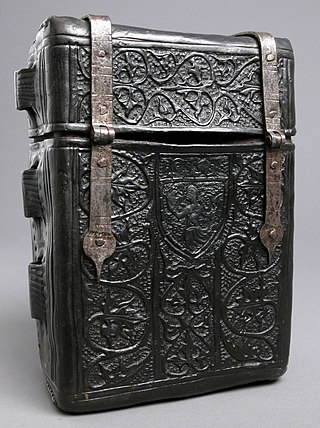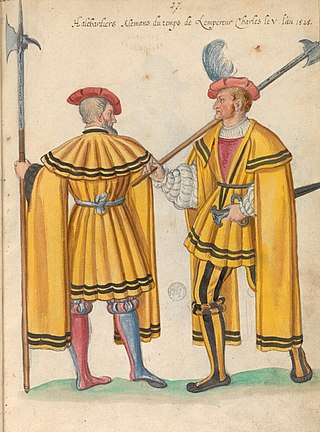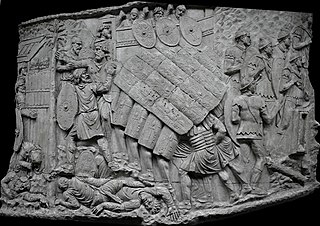Related Research Articles

Boiled leather, often referred to by its French translation, cuir bouilli, was a historical material common in the Middle Ages and Early Modern Period and used for various purposes. It was leather that had been treated so that it became tough and rigid, as well as able to hold moulded decoration. It was the usual material for the robust carrying-cases that were made for important pieces of metalwork, instruments such as astrolabes, personal sets of cutlery, books, pens and the like. It was used for some armour, being both much cheaper and much lighter than plate armour, but could not withstand a direct blow from a blade, nor a gunshot.

Medieval warfare is the warfare of the Middle Ages. Technological, cultural, and social advancements had forced a severe transformation in the character of warfare from antiquity, changing military tactics and the role of cavalry and artillery. In terms of fortification, the Middle Ages saw the emergence of the castle in Europe, which then spread to the Holy Land.

A halberd is a two-handed polearm that came to prominent use from the 13th to 16th centuries. The halberd consists of an axe blade topped with a spike mounted on a long shaft. It can have a hook or thorn on the back side of the axe blade for grappling mounted combatants and protecting allied soldiers, typically musketeers. The halberd was usually 1.5 to 1.8 metres long.

The Battle of Crécy took place on 26 August 1346 in northern France between a French army commanded by King Philip VI and an English army led by King Edward III. The French attacked the English while they were traversing northern France during the Hundred Years' War, resulting in an English victory and heavy loss of life among the French.

The Battle of Dettingen took place on 27 June 1743 during the War of the Austrian Succession at Dettingen in the Electorate of Mainz, Holy Roman Empire. It was fought between a Pragmatic Army, composed of the British, Hanoverian and Austrian troops, and a French army commanded by the duc de Noailles.
De re militari, also Epitoma rei militaris, is a treatise by the Late Latin writer Publius Flavius Vegetius Renatus about Roman warfare and military principles as a presentation of the methods and practices in use during the height of the Roman Empire and responsible for its power. The extant text dates to the 5th century AD.

The Battle of Arsuf took place on 7 September 1191, as part of the Third Crusade. It saw a multi-national force of Crusaders, led by Richard I of England, defeat a significantly larger army of the Ayyubid Sultanate, led by Saladin.

A cog is a type of ship that was used during the Middle Ages, mostly for trade and transport but also in war. It first appeared in the 10th century, and was widely used from around the 12th century onward. Cogs were clinker-built, generally of oak. Cogs were fitted with a single mast and a single square sail. They were used primarily for trade in north-west medieval Europe, especially by the Hanseatic League. Typical seagoing cogs were from 15 to 25 meters long, 5 to 8 meters wide, and were of 30–200 tons burthen. Cogs were rarely as large as 300 tons although a few were considerably larger, over 1,000 tons.

In ancient Roman warfare, the testudo or tortoise formation was a type of shield wall formation commonly used by the Roman legions during battles, particularly when they were the attacking force during sieges.
The military history of Germany spans the period from ancient times to the present.
The Battle of Leuven, also called the Battle of the River Dyle, was fought in September 891 between East Francia and the Vikings. The existence of this battle is known through several different chronicles, including the Annales Fuldenses and the Anglo-Saxon Chronicle. The Battle of the Dyle occurred near the present-day location of the city of Leuven in Belgium. In the 880s the Vikings established a camp there that they used as a base of operations from which to launch raids into the fractured Frankish kingdom. Efforts to verify the report of the battle from the Annales Fuldenses, specifically the huge loss of life on the Viking side, have been hindered by the lack of archaeological excavations in Belgium.

Historically, Scotland has a long military tradition that predates the Act of Union with England in 1707. Its soldiers today form part of the armed forces of the United Kingdom, more usually referred to domestically within the UK as the British Armed Forces.

David C. Nicolle is a British historian specialising in the military history of the Middle Ages, with a particular interest in the Middle East.
James Bradbury was a British historian specialising in the military history of the Middle Ages.
The vanguard is the leading part of an advancing military formation. It has a number of functions, including seeking out the enemy and securing ground in advance of the main force.

The term "Viking Age" refers to the period roughly from 790s to the late 11th century in Europe, though the Norse raided Scotland's western isles well into the 12th century. In this era, Viking activity started with raids on Christian lands in England and eventually expanded to mainland Europe, including parts of present-day Belarus, Russia and Ukraine.
Richard Abels is an American educator, historian, and professor emeritus at the United States Naval Academy. Abels is a specialist in the military and political institutions of Anglo-Saxon England. He is a Fellow of the Royal Historical Society and a Fellow of the Medieval Academy of America (2024). Abels' approach to medieval military history focuses upon the influence of culture upon the practice and representation of warfare. With his wife Ellen Harrison, Abels is also the co-author of an article examining the role played by women in the Cathar heresy based upon a statistical analysis of Inquisitiorial registers.

The Battle of Lenzen was a land battle between a Saxon army of the Kingdom of Germany and the armies of the Slavic Redarii and Linonen peoples, that took place on 4 September 929 near the fortified Linonen stronghold of Lenzen in Brandenburg, Germany. The Saxon army, commanded by Saxon magnate Bernhard, destroyed a Slavic Redarii army. It marked the failure of Slavic attempts to resist German king Henry the Fowler's expansionism to the Elbe.

John D. Hosler is a medieval historian and Professor of Military History at the Command and General Staff College at Fort Leavenworth, Kansas. He specializes in the history of warfare in Europe and the Near East during the 11th-13th centuries.
The Battle of Sherston was fought in Sherston, England, from 25 to 26 June 1016. between the forces of King Edmund Ironside and Danish king Cnut as a part of Cnut's invasion of England. The West Saxons, fighting for Edmund, were victorious against the Danish and their English allies.
References
- ↑ Richard Philip Abels and Bernard S Bachrach (eds). The Normans and Their Adversaries at War: Essays in Memory of C Warren Hollister. Boydell & Brewer. Revised edition. 2001. ISBN 9780851158471. (Warfare in History, ISSN 1358-779X, volume 12). Page 181